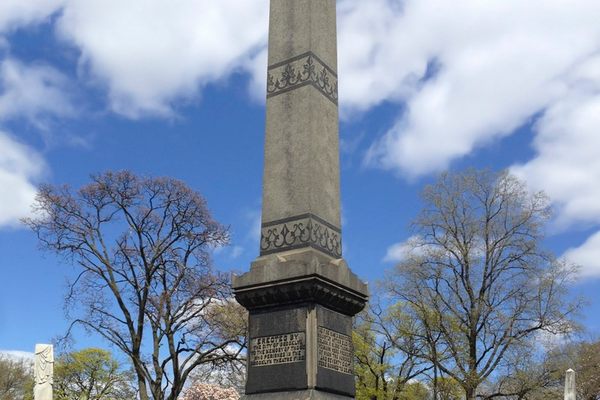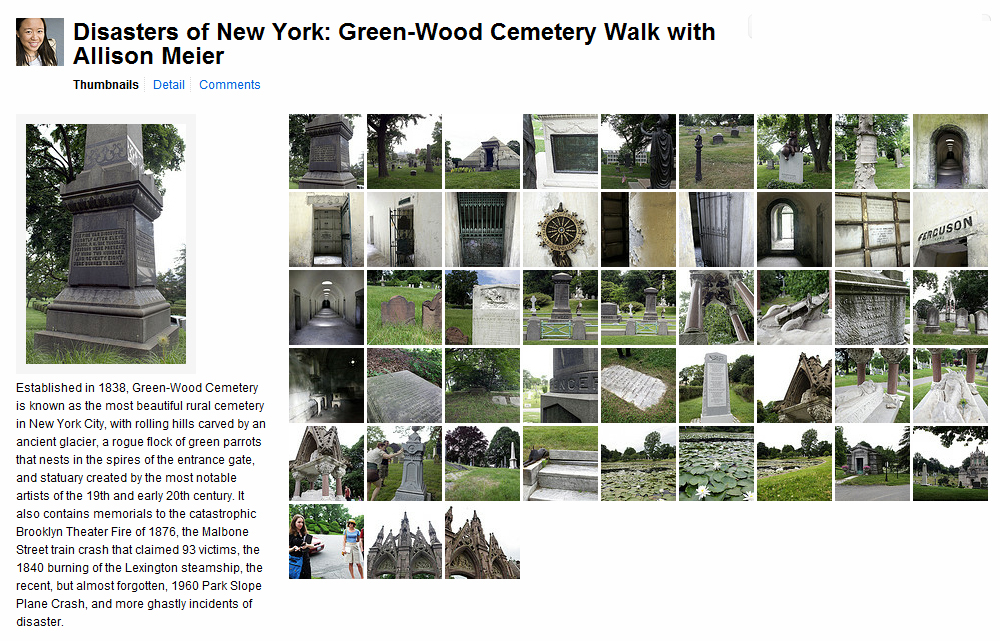Disasters of New York at Green-Wood Cemetery

On June 9, Atlas Obscura’s resident cemetery aficionado, Allison Meier, resurrected her sold-out Obscura Day tour of disaster memorials at Brooklyn’s own Green-Wood Cemetery.

(All photographs by Kathryn Yu)
The history of New York City is rolled out before you in the grassy plots and hillside burials of Green-Wood Cemetery in Brooklyn. While in the rest of the city even something as significant as a steamship fire that killed over a 1,000 or a plane crash that happened only 50 years ago can be quickly forgotten in the rapidly evolving urban architecture, in the cemetery the stories are preserved through monuments to their victims. On June 9, 2012, I lead a Disasters of New York exploration with 20 people through Green-Wood. The tour had also been offered on Obscura Day in April 2012, but had sold out so this was an opportunity for more people to discover these forgotten stories of New York disasters.


As the first of New York’s rural burial grounds, having been established in 1838, almost all of the city’s catastrophes of the mid-to-late 19th century and 20th century cast some poor souls into the soil of the Brooklyn cemetery. Our walk focused on 12 disasters, including the Brooklyn Theatre Fire of 1876, where over 278 people perished, 103 of whom are buried under an obelisk in Green-Wood, as well as the General Slocum Steamship Fire of 1904 that killed over 1,000, the Wall Street Bombing of 1920 that killed 39 and scarred the Financial District with an anarchist attack, the Malbone Street Wreck of 1908 that killed over 97 in a gruesome crash in the subway by Prospect Park, and the Park Slope Plane Crash of 1960 which killed 128 and set fire to a corner of the Brooklyn neighborhood. We also visited graves of victims of disasters connected with New York, particularly major shipwrecks that happened to vessels traveling to or from the city, with the Loneys who perished on the Lusitania in 1915, and William Augustus Spencer who was lost on the Titanic in 1912 (whose family monument is shown above).


As an added bonus, our tour got to see the inside of the Green-Wood catacombs. The long group mausoleum built into a hill is rarely unlocked and incredibly eerie, with light filtering down through skylights and creaking metal doors leading to chambers lined with tombs. It was built at a time when above-ground burial was fashionable, and when the fear of being buried alive was high, and this was an option for those who could not afford to build their own mausoleum.

An unplanned highlight was when a Red-Tailed Hawk swooped down in front of us to land on the family plot of Boss Tweed, the infamously corrupt leader of Tammany Hall. Green-Wood is not only a massive cemetery containing over 600,000 graves, many of them the most legendary of New Yorkers, but it is also a lush greenspace with a diversity of birds and wildlife, as well as some of the oldest trees in the city.

While the disasters are a fascinating way to frame a visit to Green-Wood, as each reflects a particular moment in New York that shaped the city’s history, any wander around the grounds can turn up some sights both creepy and captivating. For example, the above mausoleum where a marble chair was eerily placed by a table, perhaps to be available for a visiting family to stage a service. At every corner there is a name with a life and a death that fits into the dense history of New York City.
MORE PHOTOS
DO IT YOURSELF
Green-Wood Cemetery is open to the public, seven days a week. Details here>
More on Green-Wood Cemetery in Atlas Obscura
THANK YOU TO EVERYONE WHO JOINED US!
If you’d like to be notified about future New York City events, be sure to join our Obscura Society NYC Events Announcement List
PREVIOUSLY:
October Cemetery Explorations: Calvary Cemetery
An Evening of Horror, Victorian Grand Guignol Style
Seeking Hidden Symbolism in Greenwood Cemetery





Follow us on Twitter to get the latest on the world's hidden wonders.
Like us on Facebook to get the latest on the world's hidden wonders.
Follow us on Twitter Like us on Facebook